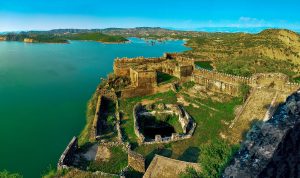
Burzil Pass, Historic caravan route between the cities of Srinagar and Gilgit.
October 26, 2021
Lal Suhanra National Park, South Asia’s largest nationals park.
October 26, 2021
Dams are not just concrete masses that hold water in one place. Many times they are also impressive. The Mangla Dam is the seven largest dam in the world is located on the river Jhelum in the Mirpur district of Azad Kashmir, Pakistan.
History
The Indus water treaty signed in 1960 under the aegis of World Bank gave right to India over Sutlej, Ravi, and Beas Rivers whereas Pakistan gained rights to the water of Jhelum, Ravi, and Chenab rivers along with some monetary compensation, received the rights to develop the Chenab, Jhelum, and Indus river basins.
The entire irrigation system of Pakistan was dependent on unregulated flows of the Indus and its major tributaries till 1967. The lack of water during critical growing periods resulted in a very low agricultural yield annually. This problem stemmed from the seasonal variations in the river flow due to monsoons and the absence of dams to store a vast amount of surplus water during monsoon season resulted in water wastage.
Mangla Dam was the first ever mega multipurpose dam commenced in 1963 and completed in 1967. Mangla Dam project has been upgraded several times but it displaced more than 100,000 people. It cost $ 434.505 million (Rs. 15.587 billion) and was funded by the World Bank and the Asian Development Bank.
Tourism
Mangla Lake and its surroundings offer panoramic views along with various water sport activities. It is a huge lake filled with deep blue water that offers a soothing effect to the eyes. The nearby Power House is spectacular for its stunning mural paintings. Many areas within the city are restricted to the general public due to military establishment in the city but in order to facilitate tourism in the city, one side of the lake is developed for recreational activities like fishing, boating, and many other water sports. The Mangla Dam makes a good weekend excursion from either Islamabad or Lahore.
